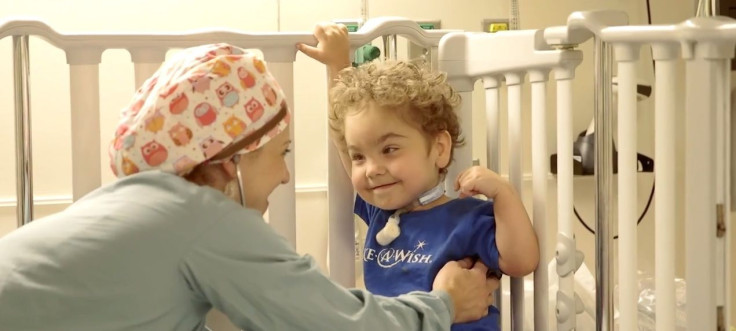3D-Printed Splints Open Airways, Restore Breathing Of 3 Babies With Rare Life-Threatening Condition

For the Gionfriddo family, the birth of their newborn son Kaiba in 2011 was nothing short of joyful. But six weeks in, their joy turned to terror as Kaiba often began to stop breathing, his airways collapsing without warning as a result of his severe tracheobronchomalacia, a condition that affects one out of every 2,200 children born. Doctors feared Kaiba would soon die.
Three years later, thanks to a revolutionary use of 3D printing technology, Kaiba and others like him are alive and vibrant, a new study from the University of Michigan reports.
When Kaiba first came under the care of Dr. Glenn Green, an associate professor of otolaryngology and faculty member at the University of Michigan C. S. Mott Children’s Hospital, Green decided to team up with fellow professor and biomedical engineer Dr. Scott Hollister to design a biodegradable airway splint that could support a windpipe and allow it to grow properly. The splint’s shape and size was customized using images from Kaiba’s CT scans, made with a polymer called polycaprolactone, and ultimately created through a specialized laser-based 3D printer. Though never before used in such a capacity, Green obtained emergency permission from the FDA.
Only 21 days after the splint was inserted, Kaiba was taken off ventilators, and has been able to breathe freely since. “For Scott and I, Kaiba’s case is definitely the highlight of our careers so far. To actually build something that can save a person’s life? It’s a tremendous feeling,” Green wrote in a blog post celebrating Kaiba’s recovery in 2013.
As the new U of M study explains, Green’s technique has since been refined and utilized for two other children with similar breathing difficulties, Garrett Peterson and Ian Orbich, both of whom have recovered from their life-threatening conditions with no complications. “I am thankful every single day that this splint was developed. It has meant our son’s life. I am certain that if we hadn't had the opportunity to bring Ian to Mott, he would not be here with us today,” said Ian’s mother, Meghan Orbich, in a press release.
Though the study cautions that further testing needs to identify any potential risks that can come with the procedure, Green and his colleagues are very hopeful (Hollister and Green have filed for a patent application for their device), “The potential of 3D-printed medical devices to improve outcomes for patients is clear, but we need more data to implement this procedure in medical practice,” said Green in the same press release.
According to Dr. Richard G. Ohye, head of pediatric cardiovascular surgery at C.S. Mott and the surgeon who inserted the splints, clinical trials on this procedure might someday open up the possibility of regularly treating even less severe cases of tracheobronchomalacia, an incurable but self-limiting condition that nonetheless has been reported in up to 15 percent of infants and 30 percent of young children who have undergone bronchoscopy for evaluation of respiratory distress, according to a 2009 review from the journal Radiology.
It appears that for those like Kaiba, the future is brighter than it’s ever been before.
Source: Green G, Morrison R, Hollister S, et al. Mitigation of Tracheobronchomalacia with 3D-Printed Personalized Medical Devices in Pediatric Patients. Science Translational Medicine. 2015.



























